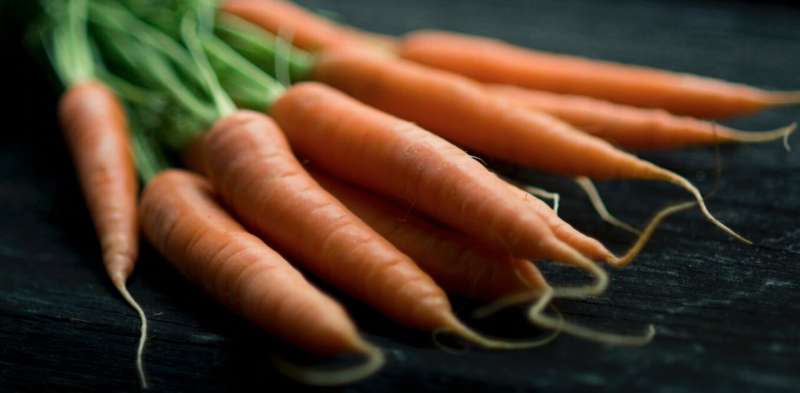This article has been reviewed according to Science X's editorial process and policies. Editors have highlighted the following attributes while ensuring the content's credibility:
fact-checked
trusted source
written by researcher(s)
proofread
Why do we need to eat so many vegetables, and what does a serving actually look like?

Most Australian adults would know they're meant to eat two or more servings of fruit and five or more servings of vegetables every day. Whether or not they get there is another question.
A recent national survey reported 45% of Australian women and 56% of Australian men didn't eat enough fruit. And 90% of women and 96% of men didn't eat enough vegetables. This figure is worse than for the preceding 10 years.
Men had on average 1.6 servings of fruit and 2.3 servings of vegetables per day, and women had 1.8 servings of fruit and 2.5 servings of vegetables. A serving of fresh fruit is a medium piece (about 150 grams) and a serving of vegetables is half a cup of cooked vegetables or about a cup of salad.
Why do we need so many veggies?
A high intake of fruit and vegetables lowers the risk of type 2 diabetes, heart disease, stroke and some cancers. These chronic diseases are unfortunately common—it's been estimated A$269 million could have been saved in 2008 if everyone in Australia met fruit and vegetable recommendations.
The recommendation to include plenty of vegetables and fruit in our diet is based on a large body of evidence showing the risk of a range of health conditions is reduced as we eat more fruit and vegetables. The specific targets of two servings for fruit and five to six servings for vegetables are largely based on nutrient requirements for healthy people and what diets usually look like for the average Australian.
So to set these guidelines, certain assumptions are made about dietary practices, such as breakfast being based around cereal/grain and dairy foods, and main meals being comprised of meat and vegetables, usually with a side of something starchy like rice, pasta or the humble potato—an Australian staple.
Does this mean it's the only pattern to meet all the nutrient requirements? No. Could an adult be equally healthy if they ate three servings of fruit and four servings of vegetables? Yes, probably.
Some recent research even suggests our current targets don't go far enough. It estimates an optimal intake for reducing our risk of heart disease and early death to be around 10 servings of fruit and vegetables a day. Whether we are aiming for two and five, or 10 servings, is somewhat academic—the clear message is most of us need to increase our fruit and vegetable intake.
Why is two and five such a hard ask?
The populations of most Western countries report eating far less fruit and vegetables than they're supposed to. So what's making it so hard for us to get to two and five?
Diets higher in fat, sugar and grains are generally more affordable than the recommended healthy diets high in fruit and veg. In fact, for Australians on low incomes, a healthy food basket for a fortnight would cost 28 to 34% of their income, up to twice the national average for food expenditure.
As a result, people with limited access to food for financial reasons often choose foods with high energy content (because they are filling) over those with high nutritional value but low energy content like fruit and vegetables. These high-energy foods are also easy to over-consume and this may be a contributing factor to weight gain. People who are poorer generally have a diet poorer in quality but not lower in energy content, which contributes to a higher rate of obesity, particularly in women.
Fresh fruit and vegetables cost more to purchase on a dollars per kilojoule basis, and also perish more quickly than processed foods. They take more time and skill to prepare and, after all of that effort, if they don't get eaten for reasons of personal preference, they go to waste. For many it may not stack up financially to fill the fridge with fruit and vegetables. Under these circumstances, pre-prepared or fast food, which the family is sure to eat without complaint or waste, is all too convenient.
How we can increase veggie intake
The home and school environments are two key influencers of children's food preferences and intakes. Parents are the "food gatekeepers" and role models particularly for younger children. Where there is parental encouragement, role modeling and family rules, there is an increased fruit and vegetable intake.
Dietary behaviors and food choices often start in childhood and continue through adolescence to adulthood. So encouraging fruit and vegetable intake in schools by mechanisms such as "fruit snack times" may be a good investment.
Policy approaches include subsidies on healthy foods. Other examples include levying a tax on foods of low nutritional value, improved food labeling, and stricter controls on the marketing of unhealthy foods. In Australia debate continues around a tax on sugar-sweetened beverages, which could be used to subsidize healthy foods such as fruit and vegetables.
Research has found the more variety in fruit and vegetables available, the more we'll consume. Those who meet the vegetable recommendation are more likely to report having at least three vegetable varieties at their evening meal. So increasing the number of different vegetables at the main meal is one simple strategy to increase intake.
This could be made a journey of discovery by adding one new vegetable to the household food supply each week. Buying "in season" fruit and vegetables and supplementing fresh varieties with frozen and canned options can bring down the total cost. Then it's a matter of exploring simple, quick and tasty ways to prepare them so they become preferred foods for the family.
This article is republished from The Conversation under a Creative Commons license. Read the original article.![]()


















